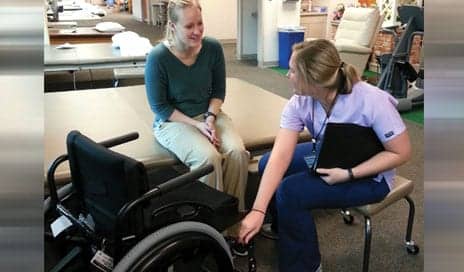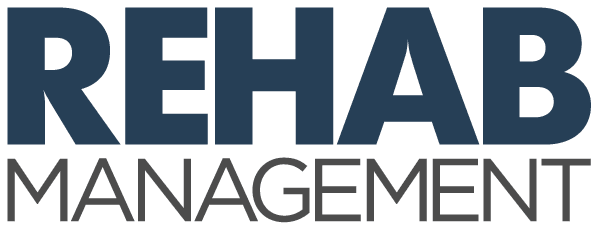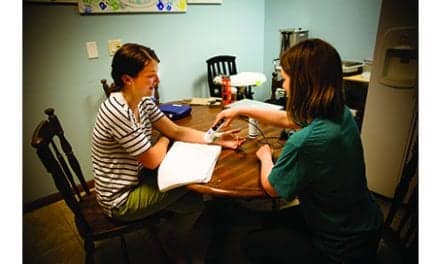Documenting the medical necessity of wheelchairs, seating systems, and other forms of durable medical equipment is often seen as a daunting task by therapists and equipment providers alike. Although often intimidating, through the use of a thorough evaluation and seating assessment, the obtainment of a complete medical history, and foundational knowledge of the equipment to be obtained, as well as the correlating justification requirements, even the inexperienced clinician can create a bulletproof letter of medical necessity (LMN).
A strong LMN is founded on the information that is obtained through the evaluation and seating assessment. The importance of developing a complete medical history is key. The evaluating therapist should not only acquire a list of diagnoses within the client’s medical history, but also carefully assess other factors that parallel a diagnosis, such as pain, upper-extremity weakness, poor trunk control, or generally decreased function, for it may be these other factors, often referred to as secondary diagnoses, that play a larger role in determining the equipment that will be selected. In addition to the obtainment of a client’s medical history, it is imperative that the impact of the client’s diagnosis on the individual’s performance of mobility-related activities of daily living (MRADL) is addressed within the evaluation.
No longer is it acceptable, when justifying equipment such as a manual chair, to simply state that the client would have difficulty getting to the kitchen or bathroom without said equipment. Today, the evaluating therapist must clearly document, within the LMN, the client’s lack of ability to perform a specific MRADL (ie, toileting, bathing, feeding, dressing, etc) as a result of the client’s lack of mobility. Therefore, the therapist must acquire this information during the evaluation process.
Identifying and Defining Mobility Limitation
A limitation in mobility is defined as a physical limitation that prevents the client from successfully accomplishing MRADL, including but not limited to toileting, bathing, or dressing. It may also be interpreted as a limitation that significantly increases the risk of injury or mortality due to the attempt on behalf of the client to compete the MRADL, or the lack of ability to perform the MRADL in a safe manner, or within a reasonable time frame.
Following a comprehensive evaluation, and the assessment for mobility limitations, the therapist should have all of the necessary information to create a LMN, which serves to justify every component of the equipment that is being recommended as a result of the evaluation process. This LMN will be signed by the evaluating therapist as well as the ordering physician, and submitted to the funding source, accompanied by other supportive documentation such as physician’s notes and supplementary data (ie, photographs, standardized testing, etc).
When is the Request for Mobility Equipment Justified?
When the above-noted mobility limitation cannot be adequately rectified by the use of an assistive device such as a cane or a walker, the evaluating therapist may create a LMN, requesting funding for a manual wheelchair for the client, provided the following apply: 1) The client’s home demonstrates adequate accessibility, including but not limited to the width of doorways, turning radius within bathrooms and other compact areas of the home; and surface heights of tables, countertops, and sinks are accessible from wheelchair level. 2) The client will be using the proposed manual wheelchair routinely within the home, and this use will notably improve the client’s ability to complete the MRADL safely and efficiently. 3) The client is willing to use the proposed equipment and is physically capable of doing so in a safe manner, within the home.
A client who meets the above criteria may be considered to have met the basic medical-necessity requirement for acquisition of a manual wheelchair, and with proper supportive documentation, may acquire a manual wheelchair for in-home use. In the event the client is unable to self-propel a manual wheelchair and does not have a caregiver who is capable of doing so, the client may qualify for the provision of a power wheelchair. Power wheelchairs may be deemed medically necessary if the client meets all of the previously mentioned criteria for manual wheelchair acquisition, but does not have the capability to manually self-propel a wheelchair, due to perhaps upper-extremity weakness, the client’s weight, or respiratory or cardiac status. The evaluating therapist must document key findings within the LMN when attempting to justify a power wheelchair. The therapist must delineate the reason the client is not physically capable of self-propelling a manual wheelchair, and follow that with documentation that the patient is capable of safely operating a power wheelchair within the home.

Justification of Options and Accessories
In addition to the wheelchair base, a variety of options and accessories also require justification within the LMN. As with the wheelchair base, it is imperative that the justification for options and accessories including but not limited to tilt, recline, elevating leg rests, arm troughs, and one-arm drive options also correlate with the client’s ability to increase function, safety, and MRADL within the home. Options and accessories may also be deemed medically necessary if they successfully allow the client to maintain current functional activities in the home and/or prevent debility in the foreseeable future.
Considerations for medically necessity of common options and accessories include the following: Reclining back or tilt systems may be considered medically necessary if the patient resides within the wheelchair for a minimum of 2 hours per day and has at least one of the following diagnoses: noncorrectable hip angle; significant extensor tone, thus limiting the client’s capability to be positioned in a standard seated position; or a medical need to reposition to a supine or recumbent position two or more times per day when transfers out of the chair are significantly limited, often seen in the case of clients who present with hypotension or those with poor trunk control/strength who require periods of rest while seated. Elevating leg rests may be considered medically necessary provided the client presents with an orthopedic or musculoskeletal diagnosis that prevents flexion of 90 degrees at the knee, deemed necessary for standard leg rest and foot plate use; or the client presents with significant lower-extremity edema and has qualified for a seating system with an adjustable seat to back angle (ie, a reclining back option). Articulating leg rests are often justified as medically necessary if needed to prevent hip rotation and/or to maintain proper positioning of the lower extremities while seated in the wheelchair.
One-arm drive options are often easily justified if the client presents with significant physical limitations to one upper extremity and is capable of self-propelling with only one hand, as is often seen in the case of hemiplegia following stroke, and the need for this equipment is expected to last beyond a 6-month period. Arm troughs are frequently used in conjunction with a hemiplegic diagnosis, (ie, stroke or spinal cord injury), and justified for the affected extremity to provide adequate support and positioning as well. Head supports may be considered medically necessary in some cases. For example, funding sources may cover head supports that are used by clients who have covered manual tilt-in-space mobility devices, or a manual mobility device that has a manual, semi, or fully reclining back. Likewise, a head support may be funded if it appears on a covered manual fully reclining back on a power mobility device, or power tilt and/or recline power seating system.
The therapist and author of the LMN are often faced with a difficult challenge in the justification of seat cushions, custom seating, and backs. As reimbursement requirements and specifications become more stringent, the evaluating therapist may benefit from including a greater amount of quantifiable information within the documentation. When justifying seat cushions or backs, pressure mapping is an excellent tool to use to provide the reviewer with quantitative data, which not only paints a better picture of how the client presents, but can also serve to better inform the reviewer of the client’s situation, especially when significant asymmetries are present. Cushioning materials can provide very specific benefits. Air cushions, for example, may decrease shear forces during scooting or transfer, and the integration of an appropriate cover may improve the cushion’s thermal properties. Cushions manufactured with foam and gel are also options, with foam offering the ability to manipulate the cushion and create contours for bony prominences of the pelvis. Viscoelastic foam allows conduction of heat away from the skin. Solid and fluid gel cushions can also assist in conducting heat away from the skin while providing a reduction in shear.
What Is Not Considered Medically Necessary?
Unfortunately, many options and accessories that appear to be greatly beneficial to the client are not deemed medically necessary in the eyes of the funding sources, including those options deemed to be for recreational or leisure use, or for use primarily outside the home. Seat elevators for wheelchair use, while quite convenient for gaining access to wall cabinets, countertops, and to aid in the performance of homemaking tasks such as laundry or cooking, are not deemed medically necessary as current peer-reviewed research does not validate its use in the treatment of injury or illness. Similarly, other items such as shock absorbers, whereas convenient, are also not deemed medically necessary.
Tying it all Together
The fabrication of a successful LMN relies upon the inclusion of several components. Many therapists prefer to create a LMN in a narrative format, which allows them to better paint a picture of the client and his or her medical and functional situation. When undergoing the LMN writing process, it is imperative to remember the reviewer who is responsible for approving the recommended equipment has never seen the client and is relying solely on the LMN for an adequate depiction of the medical and functional status of the individual as well as appropriate justification of the necessary equipment.
Remember, the more detailed picture you paint, the better understanding the funding source reviewer will have of the client, and it perhaps will better facilitate the approval process. LMNs should be quite detailed—yet concise—and include pertinent and valid information. Documentation should be careful to state not only the equipment which will be necessary for the successful completion of MRADL on behalf of the client, but also indicate why a lesser device will not suffice.
The inclusion of quantitative information (ie, manual muscle testing, SmartWheel data, Cobb’s angle measurements and/or photos or videos) should also be considered to aid in the decision-making process and encourage approval. A well-written justification will include four components: 1) The name of the requested information, 2) A description of why the requested equipment is medically necessary, 3) An explanation of why a lesser-involved equipment option will not suffice, and 4) Documentation of what could potentially occur should the equipment not be obtained.
Through the use of a well-written, comprehensive LMN, the evaluating therapist can reduce the risk of equipment denials and find great success in obtaining the recommend equipment, providing the client with the greatest level of functional independence and the best possible quality of life. RM
Kirsten N. Davin, OTD, OTR/L, ATP, SMS, is an occupational therapist, assistive technology professional, and seating and mobility specialist who conducts continuing education seminars and lectures nationwide, which she provides through both Cross Country Education as well as on a private basis. She is the owner of Escape Mobility Solutions LLC, headquartered in Pleasant Plains, Ill, and specializes in wheelchair seating, positioning, and assistive technology provision. Davin also practices at Memorial Medical Center in Springfield, Ill, as a staff occupational therapist and is currently on faculty at Rocky Mountain University of Health Professions, in Provo, Utah. For more information, contact [email protected].







Thank you for this helpful information! It is appreciated.
What criteria would be needed to approve a Vertical Wheelchair Lift for an aging Stroke Survivor who is too weak to perform the multiple transfers needed to navigate two separate stair glides which traverse two flights of stairs? Then additional transfers are required at the doctor appointment before returning home to maneuver more transfers to re-enter the residence.
I would like to obtain a LMN for a family member for a POV/scooter. My family member propels a wheelchair in his home with legs, because of arm weakness. He is 85 years old and lives alone in a multi-level split home. He is very weak and can walk about 100 feet only when he uses a walker. Doesn’t drive any more. He would like a scooter in order to get garbage out to curb and get to a nearby grocery store. Would this be covered by Medicare? Any help would be appreciated.
From an article read the use for the purposes you describe wouldn’t be considered medically necessary.
Except for the age factor and lack of upper body strength. Maybe.
Thank you for this valuable information.
You are most welcome, Tina, glad you found it useful.
-Editor